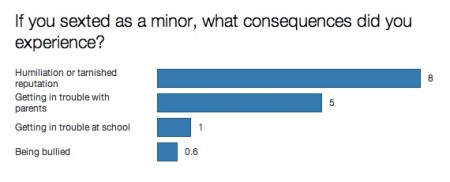The research on teen and young adult sexting is getting more granular. One of the more interesting findings in a new study at Drexel University indicated that social norms are clearly developing around the practice. Looking at frequency of youth sexting, the study – published in the academic journal Sexuality Research and Social Policy – found that, “though many respondents [undergraduates at “a large Northeastern (US) university”] acknowledged participating in sexting as minors, the frequency with which they engaged in this behavior and the number of partners with whom they exchanged sexts were fairly small,” the authors wrote.

Sexting happens in “the context of exclusive intimate relationships,” the Washington Post reports in its coverage of the research. It’s no surprise that sexting is rarely a casual behavior, and this finding “explains why the number of recipients of sexts averaged around 1.8 people,” the Post adds. A 2012 study of US college students had a similar finding: that 86% of respondents who had voluntarily sent a sext of themselves (hadn’t been pressured to) said the photo wasn’t seen by anyone but the intended recipient.
Low incidences of harm
Sexting also rarely results in emotional and other harm. “They may be sexting, but they’re not feeling the consequences,” as the Post put it, consequences that are very rare. “For the study’s authors, this finding was actually heartening. It suggests, they said, that most teens aren’t experiencing severe bullying, harassment or legal punishment as a result of exchanging sexts.”
Unlike a number of other US studies that focused on sexually explicit photos, this one looked at both text and photos. So the overall percentage that most of the new coverage zoomed in on is higher – 54% – potentially leading to alarmist messaging (see this). But the figure for respondents having sent sexually explicit photos of themselves lined up with other studies; for example, the 2012 study in Massachusetts got 30% for the same behavior; it also looked at the differing effects from coerced vs. consensual sexting.
Study that included younger ages
An earlier study at the University of New Hampshire which looked at a broader age spectrum (10-17) turned up much lower numbers. It found that 2.5% of US minors had “sexted,” and even that low percentage included non-sexually explicit pictures (showing subjects in underwear or bathing suits or even fully clothed in sexy poses). So, as I wrote back then, only 1.3% could be considered classifiable as child pornography and illegal.
A finding the Drexel University researchers seemed to want to emphasize was that “respondents demonstrated a general lack of awareness regarding legal consequences of underage sexting, with knowledge of legal consequences having a modest deterrent effect.” Please see the journal article for more.
Related links
- About the much-needed sexting typology from the University of New Hampshire (2011)
- “Don’t hype sexting risks to teens,” a 2012 Massachusetts study suggested
- “Another high-profile sexting study: Takeaways for parents” (also in 2012)
- “Net safety’s ‘3 alarmist assumptions’: Researcher”

[…] “Zooming in on social norms: Youth sexting study” […]